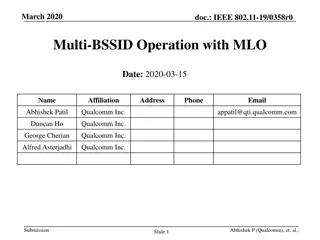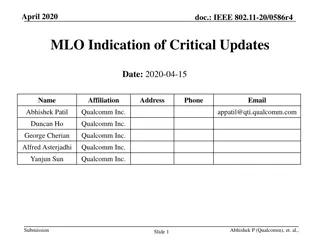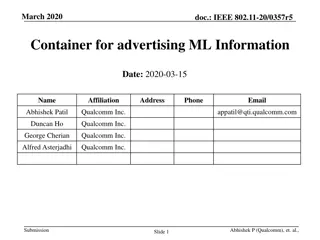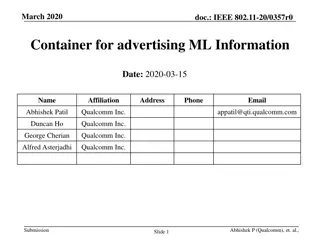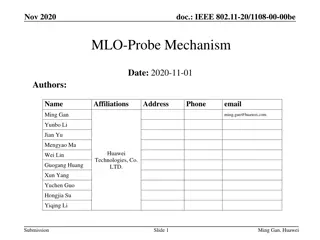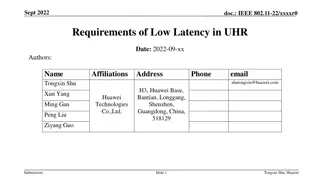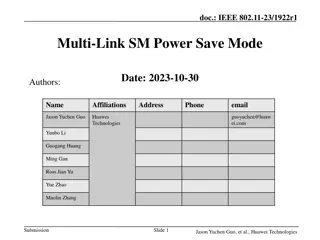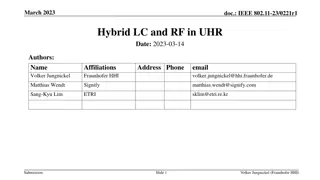Multi-BSSID Operation with MLO Overview and Signaling Considerations
The document discusses the integration of Multiple BSSID set feature and Multi-Link Operation (MLO) in IEEE 802.11 networks. It delves into the setup of virtual Access Points (APs) on the same device with distinct attributes, the formation of common parameters across APs within an MLD, and the signa
1 views • 13 slides
Machine Learning Meets Wi-Fi 7: Multi-Link Traffic Allocation-Based RL Use Case
The paper discusses the application of a Reinforcement Learning algorithm, Multi-Headed Recurrent Soft-Actor Critic, for optimizing traffic allocation in IEEE 802.11be Multi-Link Operation networks. This work aims to enhance throughput and reduce latency in MLO-capable devices by distributing incomi
0 views • 18 slides
IEEE 802.11-23/1980r1 Coordinated AP-assisted Medium Synchronization Recovery
This document from December 2023 discusses medium synchronization recovery leveraging multi-AP coordination for multi-link devices. It covers features such as Multi-link device (MLD), Multi-link operation (MLO), and Ultra High Reliability (UHR) capability defined in P802.11bn for improvements in rat
0 views • 8 slides
IEEE 802.11-19/1575r0 Multi-Link BA Operation Overview
Presentation slides from September 2019 discussing the Multi-Link Operation (MLO) in IEEE 802.11-19/1575r0 standard. The slides cover topics such as the benefits of MLO, synchronized/asynchronized rules, terminology, architecture, and common BA sessions. The proposal aims to define an architecture s
0 views • 25 slides
IEEE 802.11-20/0586r4 MLO Indication of Critical Updates
The document discusses the need for a mechanism in the MLO framework to enable non-AP MLDs to receive updates to operational parameters without monitoring all links. It proposes that each AP of an MLD should provide an indication of updates to another AP's operational parameters. It also outlines ho
0 views • 17 slides
Efficient Information Exchange for Wireless Networks
This document discusses the optimization of information exchange in IEEE 802.11 networks to reduce management frame overhead, improve power efficiency, and streamline the process of gathering and exchanging MLO information between APs and non-AP MLDs. The proposal suggests using beacon frames and di
3 views • 30 slides
Framework for Advertising Multiple-Link Operations in IEEE 802.11
Proposed framework for advertising Multiple-Link Operations (MLO) capabilities in IEEE 802.11 networks classified into three categories: Common MLD Information, Per-Link Information, and Multiple BSSID features. Introduces a new element, Multiple Link Attribute (MLA) element, with profiles for each
0 views • 27 slides
IEEE 802.11-20/1108-00-00be MLO Probe Mechanism in AP MLD
This document discusses the design and implementation of a mechanism for a non-AP STA to send a probe request frame to an AP within an AP MLD, allowing the STA to request a probe response containing information on all APs affiliated with the same MLD as the target AP. It proposes the use of new elem
1 views • 12 slides
IEEE 802.11-22/0349r1 Feb. 2022 Discussion of NSTR and EMLSR
Discussion on the introduction of eMLSR in IEEE 802.11-22/0349r1 compared to other modes like NSTR, with a proposal to make eMLSR support mandatory on AP MLD side due to its significant gains and importance in MLO. The presentation also highlights the performance comparison between NSTR and EMLSR, a
2 views • 12 slides
Low Latency Requirements in Ultra-High Rate Communication
This document discusses the requirements and use cases of low latency in ultra-high rate communication scenarios, highlighting applications such as metaverse, cloud gaming, real-time video streaming, in-vehicle infotainment, and industrial PLC control. It also covers current methods to reduce latenc
1 views • 12 slides
Enhancing Power Efficiency in IEEE 802.11 Multi-Link SM Power Save Mode
The document discusses how Multi-Link Operation (MLO) in IEEE 802.11be can improve throughput and reduce latency but may increase power consumption for non-AP devices. It introduces the concept of Multi-Link SM Power Save mode to optimize power usage by activating multiple links only when necessary,
0 views • 10 slides
Integration of Light Communications for Enhanced Reliability in Multilink Operations
The presentation discusses the integration of Light Communications (LC) into the Multilink Operation (MLO) framework to enhance reliability and reduce latency in wireless communications. By proposing the incorporation of LC as a new offloading opportunity within the MLO framework, the potential for
0 views • 15 slides
